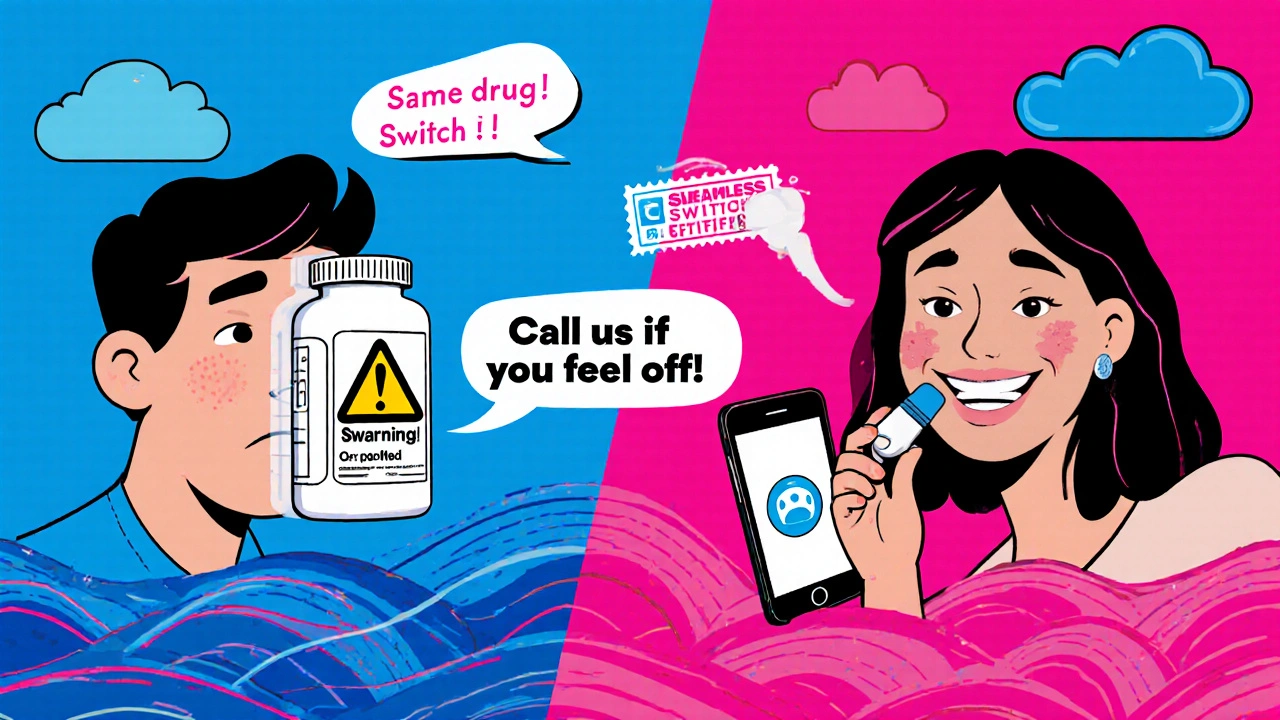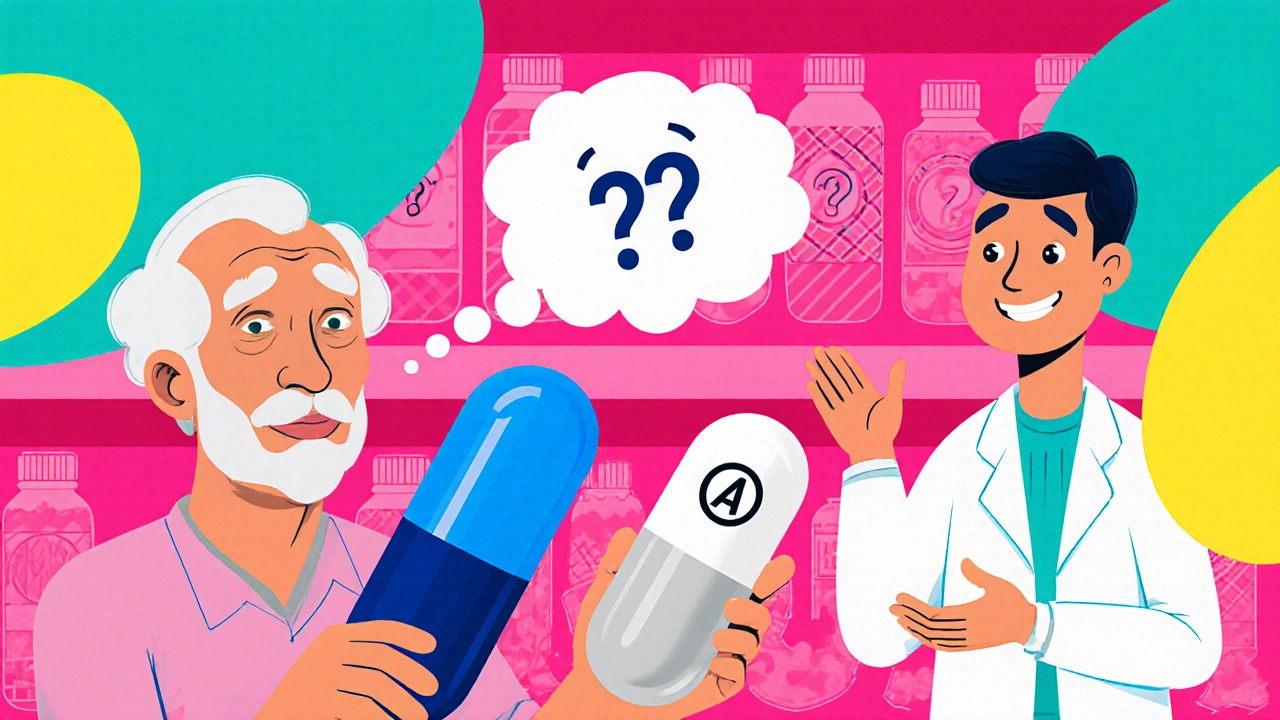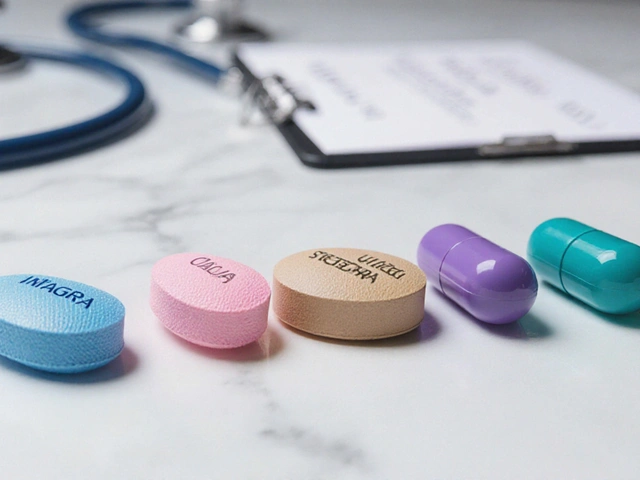Why switching to generic meds can backfire - and how to fix it
You’ve been taking your blood pressure pill for years. Same blue capsule. Same bottle. Same pharmacy. Then one day, your prescription comes back looking different - smaller, white, with a weird letter stamped on it. Your pharmacist says it’s the same drug, just cheaper. You take it. But something feels off. Your head hurts more. Your blood pressure spikes. You skip a dose. Then another. You don’t tell your doctor. You just assume the generic doesn’t work like the brand did.
This isn’t rare. It happens every day. In the U.S., 9 out of 10 prescriptions are for generic drugs. They’re just as safe. Just as effective. But medication adherence drops by 15% after a switch - not because the medicine changed, but because the patient believed it did.
The problem isn’t chemistry. It’s perception.
The science behind the fear
Generic drugs aren’t knockoffs. They’re exact copies - same active ingredient, same dose, same way of being absorbed. The FDA requires them to match brand-name drugs within 80-125% of the same blood concentration levels. That’s the same range of variation you’d see between two batches of the brand-name pill made months apart.
So why do people feel worse?
It’s called the nocebo effect. Same as placebo, but backwards. If you believe a pill won’t work, your brain can make you feel worse - even if the pill is identical. In one study, patients given identical placebo pills were told one was a brand-name drug and the other was generic. Those who thought they were taking the generic reported 18% more pain and were 32% more likely to take extra pills to compensate. The pills were the same. The belief wasn’t.
And it’s not just in labs. Real patients report side effects after switching - nausea, dizziness, fatigue - that disappear when they go back to the brand. But when researchers tested those same patients with double-blind switches, the symptoms vanished. The drug didn’t change. The label did.
Where the switch goes wrong
Not all drugs are created equal when it comes to switching. Some are fine. Others? Not so much.
For statins - cholesterol drugs - switching to generic often improves adherence. Why? Because the copay drops from $80 to $10. People take them more.
But for blood thinners like warfarin, thyroid meds like levothyroxine, or seizure drugs like lamotrigine? Trouble. These are narrow therapeutic index drugs. Tiny changes in absorption can matter. A 2017 study found a 0.8% higher hospitalization rate after switching to generic levothyroxine. That might sound small. But for someone with heart disease or epilepsy, even a 1% risk increase means real consequences.
And then there’s the pill itself.
Generics look different. Color, shape, size, imprint. For older adults, that’s a nightmare. A University of Michigan study found 28% of seniors get confused after a switch. They think it’s a new drug. They skip it. Or they take two because they’re not sure if they already did. One woman in Perth told her pharmacist she stopped her antidepressant because the generic was “too small” - she thought it was a children’s pill.
Even worse? Inactive ingredients. The fillers, dyes, coatings. These don’t affect how the drug works - but they can trigger allergies. About 3.7% of people react to these. A red dye in one generic version of a seizure drug caused rashes in a few patients. The brand didn’t have it. The patient didn’t know why they broke out. They blamed the drug. Stopped taking it.
What works: Real-world fixes that actually help
There’s no magic bullet. But there are proven steps that make a difference.
1. Talk before you switch
Most switches happen without a word. Pharmacist hands you the bottle. You leave. That’s it.
But research shows: if a pharmacist spends just 3.7 minutes explaining the switch, adherence jumps by 31%. That’s not a lot of time. But it needs to cover four things:
- “This is the same medicine. Same active ingredient. Same effect.”
- “It looks different because the company made it differently. That’s normal.”
- “It’s cheaper. You’re saving $70 a month.”
- “If you feel different, call us. Don’t stop.”
Right now, only 19% of pharmacists actually invite patients to ask questions. That’s a missed chance.
2. Use pill organizers - and keep them consistent
One patient in Brisbane switched from a large yellow pill to a tiny white one. She started mixing it up with her vitamins. She ended up in the ER. After her pharmacist gave her a color-coded pill box and labeled each slot with the drug name, her adherence went from 42% to 91%.
Same manufacturer? Even better. Some companies make both the brand and the generic. If you’re on a critical drug, ask if the generic is made by the same company. It’s often the same pill, just sold under a different name.
3. Get your meds synced
Most people have 3-5 prescriptions. Each has a different refill date. You’re juggling bottles. You forget. You skip. A medication synchronization program - where all your refills are due on the same day - cuts missed doses by 18% for generic users. It’s simple. Ask your pharmacy if they offer it.
4. Use tech to stay on track
Apps like AiCure use your phone camera to watch you take your pill. If you miss one, they text you. In a 2023 study, this boosted adherence by 37% during brand-to-generic switches. It’s not about surveillance. It’s about accountability.
When you should avoid the switch
Not everyone should switch. Here’s when to hold off:
- You’re on warfarin, levothyroxine, or a seizure drug - and you’ve been stable for months.
- You’ve had side effects after a previous switch - even if it was “just in your head.”
- You’re over 65 and take 5+ pills a day.
- You’ve been told your condition is fragile. Heart failure. Epilepsy. Organ transplant.
If you’re in one of these groups, talk to your doctor before switching. Ask: “Is there a reason to change?” Sometimes, the brand is worth the cost.

What’s changing in 2025
The FDA is rolling out new rules starting January 1, 2025. Generic manufacturers must now include patient education sheets with every switch. No more silent substitutions. Pharmacies will have to hand you a one-page note explaining: what changed, why, and what to watch for.
Also, the Generic Pharmaceutical Association is launching a “Seamless Switch” certification. If a generic for a critical drug looks the same as the brand - same color, same shape, same imprint - it gets a stamp. That’s huge. It means fewer confused seniors. Fewer skipped doses.
And the Inflation Reduction Act? It caps out-of-pocket costs at $2,000 a year for Medicare users. That means cost won’t be the reason people skip pills anymore. But now, perception will be the biggest barrier.
What you can do today
You don’t need to wait for new rules. Here’s your action list:
- When you get a new generic, ask: “Is this the same as before?” Don’t assume.
- Check the pill. Compare it to your old one. Note the shape, color, imprint. Write it down if you need to.
- Ask your pharmacist: “Can you tell me why this looks different?”
- Use a pill box. Label it. Don’t rely on memory.
- If you feel worse after switching, call your pharmacy. Don’t stop. Don’t guess. Call.
- If you’re on a critical drug, ask your doctor if staying on brand is an option - even if it costs more.
Generic drugs save billions. They’re safe. They work. But they’re not magic. They need you to believe in them - and someone to help you believe.
Frequently Asked Questions
Are generic drugs really the same as brand-name drugs?
Yes. By law, generics must contain the same active ingredient, strength, dosage form, and route of administration as the brand. They must also prove they’re absorbed into your bloodstream at the same rate and amount - within a strict FDA range. The only differences are in inactive ingredients (like dyes or fillers) and how they look. These don’t change how the drug works for most people.
Why do I feel worse after switching to a generic?
It’s often not the drug - it’s your mind. The nocebo effect is real. If you believe the generic is weaker, your brain can make you feel side effects that aren’t there. But it can also be real: different inactive ingredients can cause allergies or stomach upset. If you feel worse, don’t assume it’s all in your head. Call your pharmacist. They can check if the new pill has a dye or filler you might react to.
Should I avoid switching if I’m on a blood thinner or thyroid medication?
For drugs like warfarin, levothyroxine, or phenytoin, small changes in how your body absorbs the drug can matter. While generics are still safe, some patients do better staying on the same version - brand or generic - for stability. Talk to your doctor. If you’ve been stable for over a year, switching might not be worth the risk. If you do switch, get blood tests done 2-4 weeks later to make sure your levels are still in range.
Can I ask for the same generic manufacturer as my brand?
Yes. Many brand-name drugs are made by the same company that makes their generic version. Ask your pharmacist: “Is this generic made by the same company as the brand?” If yes, it’s likely the same pill, just cheaper. You can also ask for a specific generic manufacturer - not all are made equal. Some have more consistent quality control.
What if my insurance forces me to switch?
Insurance companies often require generics to save money. But you can request a medical exception. If you’ve had problems switching before, or you’re on a high-risk drug, your doctor can write a letter saying you need the brand. It’s not guaranteed, but it works in about 60% of cases. Don’t accept the switch without asking - especially if you’re stable.
How do I know if I’m taking the right generic?
Check the pill’s imprint code. Every pill has a letter or number stamped on it. Write it down when you get a new prescription. Next time, compare. If it’s different, ask why. You can also look up the imprint on websites like Drugs.com or WebMD. If the color or shape changes unexpectedly, it might be a different manufacturer. That’s normal - but you should know it’s happened.





Neoma Geoghegan
November 24, 2025 AT 00:46Simple.
Bartholemy Tuite
November 25, 2025 AT 17:29Sam Jepsen
November 26, 2025 AT 04:15Also, pill organizers? Game changer. Especially for seniors. Color code everything. Label it. Even if it feels silly.
Yvonne Franklin
November 27, 2025 AT 11:49james lucas
November 29, 2025 AT 06:47Miruna Alexandru
November 29, 2025 AT 21:55Danny Nicholls
December 1, 2025 AT 11:26Robin Johnson
December 2, 2025 AT 23:33Latonya Elarms-Radford
December 4, 2025 AT 11:15Mark Williams
December 5, 2025 AT 21:08Daniel Jean-Baptiste
December 7, 2025 AT 14:04Ravi Kumar Gupta
December 8, 2025 AT 14:44